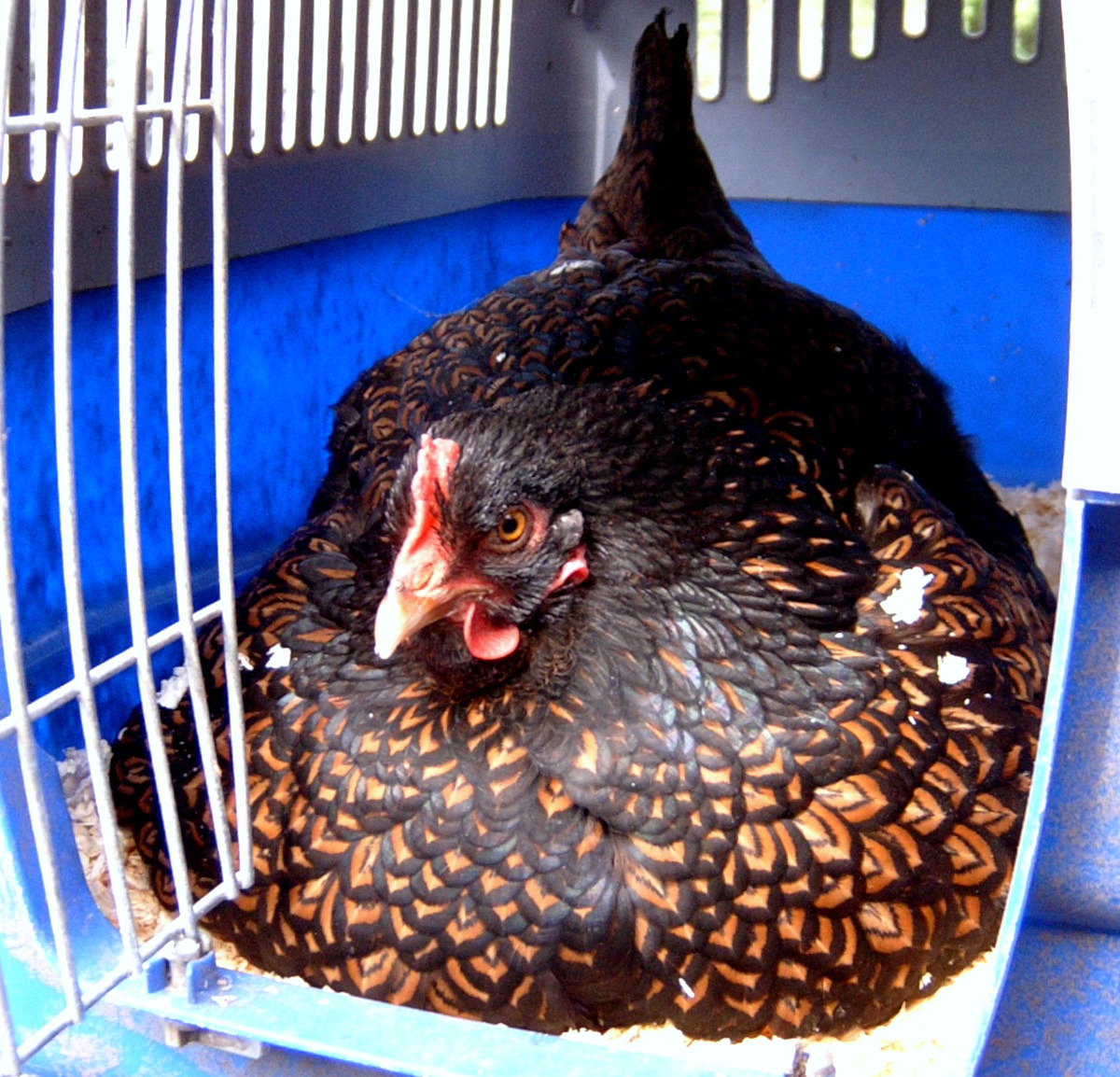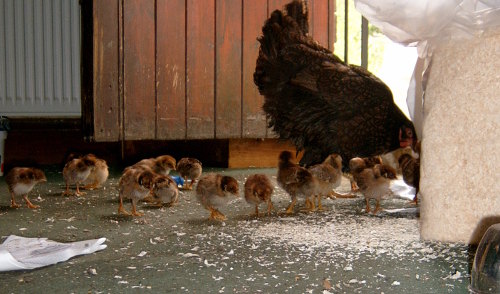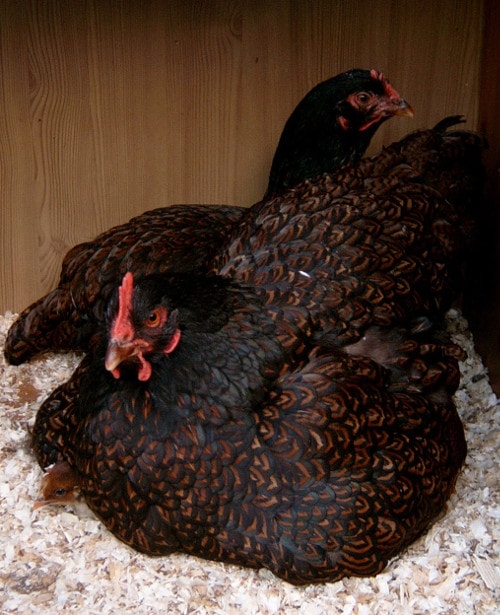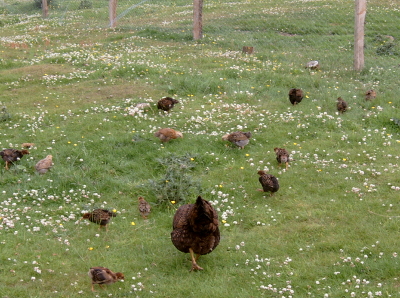Looking after the Brooding Hen and her Chicks

Table of Contents
- So how do you look after a broody hen and her babies?
- What is a broody hen?
- How do you know a hen is broody?
- Do Broody hens lay eggs?
- Should you separate a broody from the flock?
- Why do hens go broody?
- How long will a broody hen stay with her chicks?
- Do broody hens needs special or extra care?
- The risks to chicks:
- Choosing a broody coop:
- Health and Safety of the hen and chicks:
- What to feed the chicks and the broody hen :
- Slightly older and growing chicks:
- When to add growers to the adult flock:
So how do you look after a broody hen and her babies?
Most hens make excellent mothers but not all and for those that are it is an instinctive behaviour.
Over the years I have looked after countless broody hens and their chicks.
A good broody hen will teach her chicks how to eat, drink and scratch for food, call them under her wings when danger approaches, and provide warmth (by brooding them) at regular intervals during the day and all night and generally give her chicks the best start in life.
Below: Broody hens are chaos.

However hard I try to organise them, I have several hens that disappear into the undergrowth every spring and then emerge 3 weeks later with a brood in tow.
Chicks will stay under their mother all night and for various periods of time during the day. Initially the chicks will spend as much as half of their time under the mother hen keeping warm.
The hens are more than capable of raising her brood without any human help, but little chicks are very vulnerable to both predators and disease so a little human intervention can go a long way .
What is a broody hen?
A broody is a hen that has decided the time is right to raise a family by sitting on a nest of eggs and hatching them out.
A broody hen is determined and protective of her nest and chicks. It is perfectly natural behaviour brought on by a hormonal change which can be difficult to break.
Below: This bantam hen has decided the eggs are uncomfortable!

The dangers are great and many in number when you are so small, other adult hens may kill them by treading on them of tapping on their little heads, although there are several of the more docile breeds you could keep to minimise the chances of injury. Although the mother hen will try to protect her family, she can’t be everywhere all the time, especially with a large brood.
Try never to startle or bother the mother hen, if the chicks see her warning you off or getting flustered by your presence it will make the job of taming them more difficult.
How do you know a hen is broody?
Broody hens are easy to spot but here is a list of broody behaviours which can help identify one.
Here are 11 signs to look out for in a suspect broody hen:
- They sit very flat in the nest, almost like they have begun to melt.
- The comb and wattles may be an orange colour or pale.
- The chest feathers are missing to form a brood patch.
- Sitting in empty nests.
- Grumpiness and fighting.
- Not wanting to get of the nest.
- Pecking, squawking and kicking when you try to move her.
- Broody poop has to be seen to be believed, large and smelly.
- Eating and drinking much less, often only once or twice a day.
- Shouting indignantly if you pick her up and refusing to put her feet down or stand.
- Upset flock dynamic.
Below: I am always impressed by just how aggressive and stubborn a broody hen can be.
Do Broody hens lay eggs?
A broody hen will stop laying eggs.
She may lay for 3 days or so after becoming broody but will cease after that. Broodies won't normally go back to laying eggs until her chicks are at least 6 weeks old .
Should you separate a broody from the flock?
Yes, you should always separate a broody hen from the flock.
They sometimes sit randomly in nests in the coop causing all sorts of flock problems and fighting not to mention randomly starting to incubate the eggs.
Below: 2 hens tolerating each other when broody is very rare. Often they fight badly.

If you are going to break a broody she needs to be separated from the rest of the chickens and if she is to be allowed to raise a clutch she will need her own quarters away from the flock for a few weeks.
What to do when chicks first hatch under a broody hen:
When chicks first hatch under a broody hen you should leave her well alone for the first 24 to 48 hours, other than providing fresh water and chick crumb. Interfering with a newly hatched brood can end in abandonment.
It will take 24 to 36 hours for all the chicks to hatch and dry underneath her and in my experience the mother hen usually sits fast and will not budge during this time.
You can begin to interact with your new family when the hen has decided it is the right time to get off the nest and begin to move around with her brood.
Don't get too close unless the hen is fine with it and don't make sharp or jerky movements which scare her or the chicks.
Use treats and food to tame them.
Why do hens go broody?
Broodiness in chickens is a hormonal change that happens spontaneously when the conditions are right. To successfully get broody hens you need:
- Longer days.
- Ample feed.
- Warmer weather.
This is a hangover from their days as wild birds. Conditions need to be certain for raising chicks and this happens in spring as foods are more plentiful, the days are longer and the weather warmer.
How long will a broody hen stay with her chicks?
Broody hens will sit on the eggs for 21 days and stay with her chicks for 6 to 8 weeks after that. Once they are 8 weeks old she will begin to abandon them and return to her old life in the coop.
If the weather is bad it may be a week or two longer ans some chicks grow more slowly than others. With Silkies expect a hen to brood her young for 8 weeks at least.
Below: Here is 2 broody hens with their 4 week old chicks.
Broody hens will begin to roost again after they have had their chicks for 6 weeks or so. They should begin to follow her up to the perches.
You can separate a broody hen from her chicks at 8 weeks of age if they are fully feathered and the weather is mild.
Do broody hens needs special or extra care?
As long as she and her chicks have food, water and shelter away from danger the broody hen will be fine. She can eat the chick crumb, it will help her get back into condition.
In my experience broody hens need little extra help and will quite happily get on with looking after their babies.
The risks to chicks:
Other broody hens, they may well fight with each other over the chicks and the loud peeping will only goad them on. Fighting broody hens is the most serious you are likely to see hens.
Apart from all the usual chicken predators (foxes, badgers, stoats, mink etc), chicks may also be taken by rats, cats, grey squirrels, birds of the crow family, birds of prey – in fact just about any meat-eating creature, and bear in mind if the hen is snatched during the night the chicks will all die of exposure.
Below: One of my broodies with her chicks.

Young birds have no resistance to diseases which may be carried by healthy adults who have built up immunity.
Ground that has been used by adult chickens is likely to contain parasites and disease.
Coccidiosis can lead to many fatalities in young birds – Vaccinations are especially worth considering if the breed is susceptible to a particular disease or if you are planning to sell the birds on. Consult the vet before the chicks hatch to discuss vaccinations, as many have to be given at a very early age to be effective. Although vaccines are generally sold in large quantities, most of them are relatively inexpensive.
Choosing a broody coop:
To give a hen the best chance of raising her chicks successfully, she needs a sturdy, secure broody coop with food and drink available at low levels so the chicks can reach. It should include sleeping-quarters and a grass run.
The structure should be robust enough to keep out large predators, with no gaps to admit smaller ones. Wire mesh must be of a small gauge to stop rats getting in, and tiny chicks from getting out. The best ones have a completely enclosed run.
The sleeping quarters should be easy for the smallest chicks to access safely – they won’t manage big steps or a steep ramp.
Ideally the coop should have wheels or skids so it can regularly be moved to fresh ground like this one.
If a static coop is used, the base of the run can be lined with wire mesh, stapled up the sides. This makes it very secure, but you should cover the mesh with a scratching material, such as hardwood chips, to protect the chicks’ legs and feet.
Once the chicks hatch Mother Hen becomes very active, making up for the long weeks of inactivity by stretching and flapping and will benefit from a dust bath.
Chicks can easily be trodden on by their mother in a restricted space, so make sure the run is large enough. Some coops advertised as being suitable for a broody hen and chicks are barely big enough for a small guinea-pig. Watch for tunnels around the run – rats or other predators may try to dig their way in or the chicks might scratch their way out.
After hatching - Once she’s decided hatching is complete, Mother Hen will leave the nest with her chicks and will not return to sitting, she will lead her chicks out into the run and while they are busy exploring, clear out all the nesting material and replace it with fresh bedding.
If there are any eggs left in the nest they are unlikely to be viable and even if they hatch the smaller and weaker chicks are unlikely to survive. A chick that can’t escape the shell is likely to be weak or malformed and you should not help it out, it will need to much extra care.
Health and Safety of the hen and chicks:
Make sure the coop has shade and shelter from prevailing weather. Whilst the hen is able to keep the chicks warm at night, if the weather is especially cold it may be necessary to put the broody coop inside an outbuilding or shed.
Always close the hen and chicks into their sleeping-quarters at night.
Warm, damp conditions are ideal for coccidicosis eggs (oocysts) to start developing. Oocysts can be transmitted on boots and clothing and are very resilient to normal disinfectants. They can survive in empty housing and in the ground for long periods. Prevention is better than cure:
Scrub the broody coop between hatches and use a specialist product (see DEFRA approved Disinfectants information below) to destroy coccidia eggs.
Make sure the nesting area of the coop stays dry – good ventilation helps avoid humidity – and change the bedding regularly.
Regularly move the coop, or clean and disinfect the scratching material in the run.
What to feed the chicks and the broody hen :
Chicks can survive for up to 72 hours after hatching (this is how they get away with shipping day old chicks in the post in some countries) on the contents of their yolk-sacs, but you should provide food and water immediately within easy reach of the nest when hatching has begun.
Below: Teaching baby chicks to feed and drink.
Place the drinker in the run and not in the sleeping area where it may make the bedding damp or get contaminated with sawdust or shavings. Separate the feeder and drinker slightly and raise them up a little helps to keep the water clean, and prevents the surrounding ground from getting wet.
Lifting the food up a bit stops the chicks scratching or spreading the food around. It’s important to choose feeders and a waterer that is specially designed for chicks as if they can they will get into it and scratch around in it adding droppings The chicks quickly become very active and agile, climbing over and into everything.
Raise the food up a little every week as the chicks grow and use a bigger, heavier feeders that can not fall over.
If they get wet it can lead to chills, and they can drown even in shallow water. A small feeder, preferably one with a partitioned trough, will save waste and mess. It may even be necessary to suspend the feeder and drinker slightly above ground level just make sure the chicks can easily reach them without having to stretch.
Be prepared to refill both regularly. If the hen and chicks aren’t on grass, you could hang up a few fresh greens for them. Provide some chick-sized grit ( flint ) to help the chicks’ digestive systems.
You should not feed soluble (oyster shell) grit to young birds, as it can cause developmental problems. Shell shouldn’t be given until 16 weeks of age
Feed good-quality chick crumbs. These can be bought either with or without the addition of a coccidiostat (to help to guard against coccidiosis).
Keep medicated chick feed away from other animals, especially waterfowl. If it is eaten by laying hens there is usually an egg-withdrawal period (check with the manufacturer). The broody will share some of the chicks’ feed, so bear this in mind when she starts laying eggs again.
Mother Hen should have been fed mixed corn while sitting, and will need to continue with this while she’s with the chicks. She’ll probably break some up for them to eat too. Don’t let the chicks have access to feeds for laying hens.
Slightly older and growing chicks:
When the chicks are about six to eight weeks old, the hen usually starts showing signs of being ready to return to the flock and may even begin to roost away from the chicks.
Once she has decided enough is enough she should be put back with the flock and you will need to asses whether the chicks will need any further care or whether they can look after themselves.
She may peck at the chicks or tap them on the head or start laying again. The chicks should be fully feathered by now and no longer sleeping under Mum.
The hen can be allowed to rejoin the others (the pecking order may have changed in her absence so be ready for some squabbles), while the youngsters should continue to live in the broody coop.
When to add growers to the adult flock:
Continue to monitor them throughout their development. From around six ( I prefer 8 ) weeks, the chicks can gradually be changed over to a growers pellets. Always change the food gradually and at first just give a few pellets extra till they get used to it.
I introduce my chicks to all the foods they are likely to encounter, like split maize, sprouted wheat as mum will show them how to eat it. Layers’ feeds are harmful to young birds who aren’t yet ready to produce eggs.
As the youngsters develop it may be possible to identify the cockerels, not a straightforward process and it’s even been known for a cockerel to end up in with caged hens in a battery farm.
Take a look at hazards in the garden or plants that are poisonous for chickens.
Faster growing, redder combs, pointed neck and shoulder hackles and different feathering rates can be a good early indicator, but sometimes the only way of knowing for sure is when the males begin to crow. Once you’ve picked out the cockerels, you might wish to separate any breeding stock you wish to keep and deal with the rest in your preferred way.
There’s always likely to be a surplus of cockerels, and their eventual fate is something to be considered before putting eggs to hatch. It is difficult to find homes for unwanted males, and often the only answer is to dispatch them.
Introduce the pullets to the rest of the flock when they are fully grown but haven’t yet started to lay (usually at 16 to 18 weeks). By this time their mother will have forgotten them, and the procedure will be the same as for adding any new birds to an established flock. They will have to adjust to their place in the pecking order and this is much better accomplished before they have started to lay.
